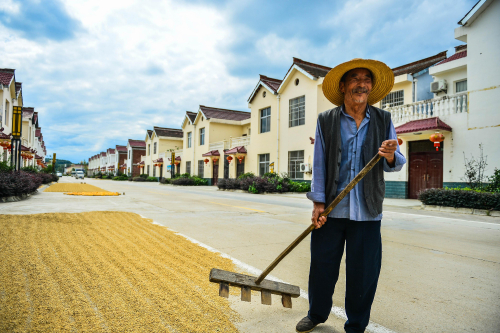|
 |
|
WELL-BEING: Li Yaode, whose family was relocated for the building of the middle route of the south-to-north water diversion project, dries harvests at his new home in Xixiang County, Shaanxi Province, on September 19, 2014 (CFP) |
"I've been living in the village for more than 50 years and life there was easy and stable," said Zhao. "So at first, I couldn't accept moving for the project."
Zhao's unwillingness became further entrenched after he visited the new location. "I'm used to life near water and the new location had no water at all, so I thought 'How could we make a living?'"
Many other villagers had the same concern. Liujialou is the richest village in Nanyang and many villagers made a living from fishing or the restaurant industry. Before the move, the local government took them to Yangling in Shaanxi Province to teach them the skills for planting fruit trees.
Zhao took this advice and started the fruit tree plantation with several other villagers. Now his business is even more successful than his former restaurant. But Zhao would still visit the former village occasionally. "It holds all my memories," said Zhao.
Ye Mingcheng, a 58-year-old fish farmer from Hubei Province, also had mixed feelings about the Danjiangkou Dam.
As a fish farmer, Ye could earn 200,000 yuan ($31,746) annually and owned a big house. But for this project, he had to move and gave up his net, cages and fish, which are worth 3.5 million yuan ($564,516).
To make up for Ye's loss, the local government gave him a two-story building. He also received compensation for the 120 net cages, each worth 1,000 yuan ($161) to 1,800 yuan ($290).
Over 400,000 people were relocated, including 345,000 people whose hometown was submerged under the massive Danjiangkou Reservoir and more than 2,000 factories closed, according to Zhang Jiyao, Director of the Office of the South-to-North Water Diversion Project Commission (SNWDPC).
"Among the 43 counties in Hubei and Henan affected by the project, 34 are impoverished," he said. "The decision to move people away from their homes and livelihoods was often the most difficult to make."
The challenges
With the new waterway come new challenges, such as protection of water quality and unforeseen natural risks in the future.
The project runs past more than 1,000 bridges. "If pollutants fall into the water from passing vehicles, we could shut the sluice gate, but then the question is how to clean the water without contaminating the local environment?" said Xu Xinyi, head of the College of Water Sciences under Beijing Normal University.
Another problem is the lack of a proper sewage plant. Danjiangkou Reservoir is under the administration of Shiyan, Hubei Province, where 90 percent of the townships and villages cannot provide enough funding for sewage plants. They also have trouble attracting the right talent to do the job.
Beijing is also capping 4,216 dry wells to prevent pollution, local authorities said. These wells can no longer provide water due to the fall in the level of the water table.
More than 3,000 of them have been filled with concrete or covered with iron plates and all of them will be shut by the end of 2015, said Wang Wei, an official with the Beijing Water Authority.
"The capping of wells will cut the channels of sewage and waste polluting the underground water and reduce the pollution risk for major water sources and protect the drinking water supply," he said.
| 